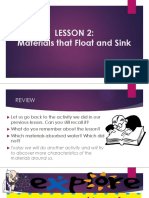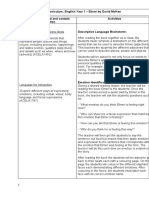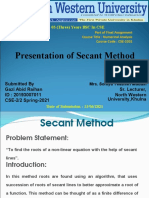0 ratings0% found this document useful (0 votes)
73 viewsWeek 3 Activities
The activities for Week 3 involve investigating floating and sinking using tap water and salt water. Students will make predictions and test various objects. Another activity involves building sandcastles using dry sand versus wet sand to see which creates a more stable structure. Students will also collect shells and items from the beach to create art designs in the sand. Other activities include an aim game by tossing shells or stones at targets, building a sandman sculpture, and making plaster of Paris casts of objects pressed into wet sand.
Uploaded by
api-357680810Copyright
© © All Rights Reserved
Available Formats
Download as PPTX, PDF, TXT or read online on Scribd
0 ratings0% found this document useful (0 votes)
73 viewsWeek 3 Activities
The activities for Week 3 involve investigating floating and sinking using tap water and salt water. Students will make predictions and test various objects. Another activity involves building sandcastles using dry sand versus wet sand to see which creates a more stable structure. Students will also collect shells and items from the beach to create art designs in the sand. Other activities include an aim game by tossing shells or stones at targets, building a sandman sculpture, and making plaster of Paris casts of objects pressed into wet sand.
Uploaded by
api-357680810Copyright
© © All Rights Reserved
Available Formats
Download as PPTX, PDF, TXT or read online on Scribd
You are on page 1/ 11
Activities for Week 3
Floating and Sinking
Floating sinking: tap water/salt water does it
make a difference?
Use the materials
around the tub to
investigate floating
sinking. Do a
prediction first then
test in the tap water
and then in the salt
water.
Teacher Page: Floating sinking: tap
water/salt water does it make a difference?
Whether an objects floats or sinks depends
on the materials it is made of, not its
weight. Water pushes up on objects with
an upward thrust. Objects that are heavy
for their size will sink, e.g. a key. Objects
that are light for their size will float e.g. a
beach ball. Some fruits float when whole
but sink when cut.
Further explanations: https://www.deakin.edu.au/arts-ed/education/sci-enviro-ed/early-
years/pdfs/floating-sink.pdf
Stable sand structures
Build a sandcastle. Try it with dry sand and then
with different levels of wet sand. Which one builds
the most stable sandcastle? Which one falls apart?
Why?
Teacher Page: Stable sand structures
You can’t build a sand castle unless the sand is wet. The liquid builds
bridges that connect the granules to one another. Damp sand sticks
together so it can be carved. Tamping down wet sand drains excess
water and allows for shaping and carving.
How to build the perfect sandcastle:
http://www.theguardian.com/lifeandstyle/2009/aug/01/how-to-build-perfect-sandcastle
Sand and shell art
Collect things from along
the beach. Make
interesting pictures and
designs.
Take photos of the
creations rather than
taking them home.
Teacher page: Sand and shell art
It is important to teach the
young to respect our
environment and not to
collect lots of sea things and
remove them from the ocean
area. It is better to leave
them in place in their natural
environment.
Take photos and research
things when you get back to
class.
Aim Game
Collect a number of things
that can be thrown or
tossed, e.g. stones, shells,
etc.
Mark out circles and
children have to toss their
item in to earn points or
just to hit the target.
I want to build a Sandman!
Use found materials and
sand/water to build your
sandman. Remember to
decorate him and give
him the required body
parts.
Create your own sand casts
Push an object into the sand to
create an indentation, it could
be a shell, your hand, foot ,
etc.
Make up a Plaster of Paris mix
and pour/spoon it in.
Wait about ½ and hour for it to
set and then remove it
carefully.
Teacher Page: Create your own sand casts
Plaster of Paris is cheap and
easily found in Bunnings and
craft stores. You should use
fresh water to make the mix.
Don’t make it too runny or it
will never set in time.
It is fragile so let them set well
in the sun and then carefully
carry in newspaper pockets or
bubble wrap. Excellent to
paint and decorate later.
For more ideas see:
http://pagingfunmums.com/2013/04/30/sand-footprint-craft-full-diy-instructions-louise/
You might also like
- The Official Sea Glass Searcher's Guide - How To Find Your Own Treasures From The Tide (PDFDrive)100% (1)The Official Sea Glass Searcher's Guide - How To Find Your Own Treasures From The Tide (PDFDrive)85 pages
- Lesson 2 - Materials That Float and SinkNo ratings yetLesson 2 - Materials That Float and Sink16 pages
- Sandcastles Made Simple: Step-by-Step Instructions, Tips, and Tricks for Building Sensational Sand CreationsFrom EverandSandcastles Made Simple: Step-by-Step Instructions, Tips, and Tricks for Building Sensational Sand Creations4/5 (6)
- Sand Art For Beginners: Step-by-Step Guide for Making Breath-Taking Sand Art as a Complete BeginnerFrom EverandSand Art For Beginners: Step-by-Step Guide for Making Breath-Taking Sand Art as a Complete BeginnerNo ratings yet
- Chapter 10: Erosion and Deposition: 5L1Ybmg44/Pub?Start False&Loop False&Delayms 3000No ratings yetChapter 10: Erosion and Deposition: 5L1Ybmg44/Pub?Start False&Loop False&Delayms 30003 pages
- Child 230 Self-Selected Lesson Plan Mariana HansenNo ratings yetChild 230 Self-Selected Lesson Plan Mariana Hansen4 pages
- Lesson 2 - Materials That Float and SinkNo ratings yetLesson 2 - Materials That Float and Sink16 pages
- Materials That Float and Sink: Bethsaida V. Berdin Cainta Elementary SchoolNo ratings yetMaterials That Float and Sink: Bethsaida V. Berdin Cainta Elementary School16 pages
- "Ocean Commotion" July 5-9, 2010 Evie Van Kirk: MondayNo ratings yet"Ocean Commotion" July 5-9, 2010 Evie Van Kirk: Monday6 pages
- Science Fun at Home 22 World Oceans Day SmallNo ratings yetScience Fun at Home 22 World Oceans Day Small3 pages
- Does It Matter? I. Introductory ConceptNo ratings yetDoes It Matter? I. Introductory Concept14 pages
- Summer was a interesting time for anyone enjoyingNo ratings yetSummer was a interesting time for anyone enjoying1 page
- Earth Science: Quarter 2 - Module 1 Weathering of RocksNo ratings yetEarth Science: Quarter 2 - Module 1 Weathering of Rocks15 pages
- ES Q2 - MODULE8 - Weathering of Rocks - Version4 WEEK ONE RO Oct 7 11 2024No ratings yetES Q2 - MODULE8 - Weathering of Rocks - Version4 WEEK ONE RO Oct 7 11 202413 pages
- Lesson 2 - Materials That Float and SinkNo ratings yetLesson 2 - Materials That Float and Sink10 pages
- Julius CO On Materials That Float and Sink100% (1)Julius CO On Materials That Float and Sink19 pages
- Carousel Curriculum Ocean Animals: A Literature-Based Thematic Unit for Early LearnersFrom EverandCarousel Curriculum Ocean Animals: A Literature-Based Thematic Unit for Early LearnersNo ratings yet
- Two Week Integrated Teaching and Learning Program Assessment 3No ratings yetTwo Week Integrated Teaching and Learning Program Assessment 311 pages
- Oral Language Profile of A Child AssignmentNo ratings yetOral Language Profile of A Child Assignment12 pages
- Culturally Responsive Teaching Reflection AssignmentNo ratings yetCulturally Responsive Teaching Reflection Assignment7 pages
- Final Learning Centre Plan - KindergartenNo ratings yetFinal Learning Centre Plan - Kindergarten6 pages
- Lesson Plan: Claudia Rocha EDUC2652 Assignment OneNo ratings yetLesson Plan: Claudia Rocha EDUC2652 Assignment One5 pages
- Cambridge Latin Course Unit 3: Quarter 2: Stage 23: Date Homework Due Lesson Homework All Roads Lead To RomeNo ratings yetCambridge Latin Course Unit 3: Quarter 2: Stage 23: Date Homework Due Lesson Homework All Roads Lead To Rome2 pages
- Maize mid-density genotyping services _ ExcellenceinbreedingNo ratings yetMaize mid-density genotyping services _ Excellenceinbreeding4 pages
- Geographical Information Center - CSU, Chico-GIS & Asset Management - RedactedNo ratings yetGeographical Information Center - CSU, Chico-GIS & Asset Management - Redacted19 pages
- Saving The Earth Starts With You: Care For God'S CreationNo ratings yetSaving The Earth Starts With You: Care For God'S Creation13 pages
- CTET - Syllabus: Structure and Content of SyllabusNo ratings yetCTET - Syllabus: Structure and Content of Syllabus18 pages
- ID-20193007011 Presentation of Secant MethodNo ratings yetID-20193007011 Presentation of Secant Method18 pages
- Remote Control System Design For The Wheeled-Robot Using Gprs/GpsNo ratings yetRemote Control System Design For The Wheeled-Robot Using Gprs/Gps12 pages
- A Study On Green Banking in India - An: Commerce Original Research PaperNo ratings yetA Study On Green Banking in India - An: Commerce Original Research Paper3 pages
- Urea, Blood ,: Test Name Result Biological Ref. Interval MethodNo ratings yetUrea, Blood ,: Test Name Result Biological Ref. Interval Method4 pages
- Course Syllabus: University of San CarlosNo ratings yetCourse Syllabus: University of San Carlos4 pages
- 11 We'Ll Bite Your Tail, Geronimo by Stilton, GeronimoNo ratings yet11 We'Ll Bite Your Tail, Geronimo by Stilton, Geronimo133 pages
- The Official Sea Glass Searcher's Guide - How To Find Your Own Treasures From The Tide (PDFDrive)The Official Sea Glass Searcher's Guide - How To Find Your Own Treasures From The Tide (PDFDrive)
- Sandcastles Made Simple: Step-by-Step Instructions, Tips, and Tricks for Building Sensational Sand CreationsFrom EverandSandcastles Made Simple: Step-by-Step Instructions, Tips, and Tricks for Building Sensational Sand Creations
- Sand Art For Beginners: Step-by-Step Guide for Making Breath-Taking Sand Art as a Complete BeginnerFrom EverandSand Art For Beginners: Step-by-Step Guide for Making Breath-Taking Sand Art as a Complete Beginner
- Chapter 10: Erosion and Deposition: 5L1Ybmg44/Pub?Start False&Loop False&Delayms 3000Chapter 10: Erosion and Deposition: 5L1Ybmg44/Pub?Start False&Loop False&Delayms 3000
- Child 230 Self-Selected Lesson Plan Mariana HansenChild 230 Self-Selected Lesson Plan Mariana Hansen
- Materials That Float and Sink: Bethsaida V. Berdin Cainta Elementary SchoolMaterials That Float and Sink: Bethsaida V. Berdin Cainta Elementary School
- "Ocean Commotion" July 5-9, 2010 Evie Van Kirk: Monday"Ocean Commotion" July 5-9, 2010 Evie Van Kirk: Monday
- Earth Science: Quarter 2 - Module 1 Weathering of RocksEarth Science: Quarter 2 - Module 1 Weathering of Rocks
- ES Q2 - MODULE8 - Weathering of Rocks - Version4 WEEK ONE RO Oct 7 11 2024ES Q2 - MODULE8 - Weathering of Rocks - Version4 WEEK ONE RO Oct 7 11 2024
- Carousel Curriculum Ocean Animals: A Literature-Based Thematic Unit for Early LearnersFrom EverandCarousel Curriculum Ocean Animals: A Literature-Based Thematic Unit for Early Learners
- Two Week Integrated Teaching and Learning Program Assessment 3Two Week Integrated Teaching and Learning Program Assessment 3
- Culturally Responsive Teaching Reflection AssignmentCulturally Responsive Teaching Reflection Assignment
- Lesson Plan: Claudia Rocha EDUC2652 Assignment OneLesson Plan: Claudia Rocha EDUC2652 Assignment One
- Cambridge Latin Course Unit 3: Quarter 2: Stage 23: Date Homework Due Lesson Homework All Roads Lead To RomeCambridge Latin Course Unit 3: Quarter 2: Stage 23: Date Homework Due Lesson Homework All Roads Lead To Rome
- Maize mid-density genotyping services _ ExcellenceinbreedingMaize mid-density genotyping services _ Excellenceinbreeding
- Geographical Information Center - CSU, Chico-GIS & Asset Management - RedactedGeographical Information Center - CSU, Chico-GIS & Asset Management - Redacted
- Saving The Earth Starts With You: Care For God'S CreationSaving The Earth Starts With You: Care For God'S Creation
- CTET - Syllabus: Structure and Content of SyllabusCTET - Syllabus: Structure and Content of Syllabus
- Remote Control System Design For The Wheeled-Robot Using Gprs/GpsRemote Control System Design For The Wheeled-Robot Using Gprs/Gps
- A Study On Green Banking in India - An: Commerce Original Research PaperA Study On Green Banking in India - An: Commerce Original Research Paper
- Urea, Blood ,: Test Name Result Biological Ref. Interval MethodUrea, Blood ,: Test Name Result Biological Ref. Interval Method
- 11 We'Ll Bite Your Tail, Geronimo by Stilton, Geronimo11 We'Ll Bite Your Tail, Geronimo by Stilton, Geronimo




















































































































